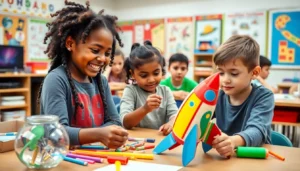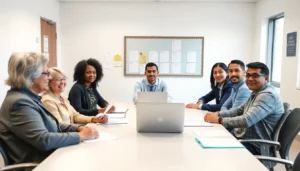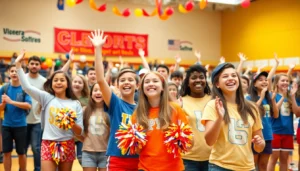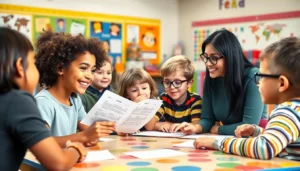Table of Contents
ToggleIn a world where traditional classrooms often resemble a scene from a horror movie, alternative education schools are like a breath of fresh air—or maybe a refreshing slice of pizza. These innovative learning environments challenge the status quo, offering unique approaches that cater to diverse learning styles. They’re not just about avoiding the dreaded pop quiz; they focus on nurturing creativity, critical thinking, and real-world skills.
Imagine a place where students can explore their passions, collaborate with peers, and actually enjoy learning. Alternative education schools break free from rigid structures, empowering students to take charge of their education. Whether it’s through project-based learning, experiential activities, or personalized curricula, these schools are redefining what it means to be educated. So, if you’re tired of the same old grind, it might be time to consider an alternative path that could lead to a brighter—and more fun—future.
Overview Of Alternative Education Schools
Alternative education schools offer diverse educational settings, specifically designed to meet the unique needs of students. These institutions prioritize engagement, creativity, and real-world applications, moving beyond standard teaching methods. Various approaches, like Montessori and Waldorf, exemplify the flexibility found in these environments.
Students in alternative education often thrive due to customized learning experiences. Personalized curricula cater to individual strengths and interests, promoting a self-directed learning approach. Project-based learning introduces practical challenges, fostering collaboration among students and encouraging problem-solving skills.
Class size typically remains smaller in alternative settings, allowing for targeted attention from educators. Smaller groups facilitate meaningful interactions and promote a sense of community within the classroom. This environment nurtures relationships, leading to increased student motivation and participation.
Moreover, many alternative education schools emphasize holistic development. This focus includes not just academic growth but also social, emotional, and physical well-being. Schools incorporate arts, outdoor activities, and mindfulness practices into their curricula, giving students a well-rounded education.
Alternative education schools redefine the traditional learning experience. They cater to a variety of learning styles while aiming to inspire lifelong learners. By providing supportive environments, these schools help students build essential skills for success beyond their school years.
Benefits Of Alternative Education Schools
Alternative education schools offer various benefits that cater to individual student needs. These environments provide unique learning experiences, making education engaging and effective.
Personalized Learning Approaches
Personalized learning approaches thrive in alternative education settings. Students receive tailored plans focusing on their strengths and interests. Educators take time to understand each student’s learning style, which fosters greater engagement. Flexibility in pacing allows students to progress at their comfort levels. One-on-one support enhances comprehension, encouraging mastery of subjects before advancing. Ultimately, this individualized attention promotes self-confidence and motivation.
Diverse Curriculum Options
Diverse curriculum options expand students’ horizons in alternative education schools. These programs often include non-traditional subjects, such as environmental science or the arts. Hands-on projects and real-world applications deepen understanding and relevance. Students can explore topics that align with their passions, enhancing intrinsic motivation. Opportunities for interdisciplinary learning encourage creativity and critical thinking. This breadth of knowledge fosters well-rounded individuals prepared for life beyond academics.
Types Of Alternative Education Schools
Alternative education schools encompass various innovative models that cater to diverse student needs and learning styles. The following sections detail several prominent types of alternative education schools.
Montessori Schools
Montessori schools emphasize independence and hands-on learning. Students engage with specially designed materials that encourage exploration and self-directed activity. These schools often feature mixed-age classrooms, which foster peer learning and collaboration. Children in Montessori settings develop critical thinking skills while encouraging a love for learning. Educators act as facilitators, guiding rather than directing, which nurtures students’ innate curiosity.
Waldorf Schools
Waldorf schools prioritize creativity and imagination in education. A holistic approach integrates arts, music, and movement into the curriculum, supporting emotional and cognitive development. Students progress through various stages, with each stage tailored to their developmental needs. Teachers at Waldorf schools often stay with their classes for several years, promoting strong teacher-student relationships. This continuity allows educators to tailor their teaching styles to individual students, fostering a supportive environment.
Charter Schools
Charter schools operate independently while receiving public funding. These schools often focus on specific educational missions, ranging from arts to STEM. Flexibility in curriculum design enables them to implement innovative teaching strategies. Enrollment often involves a lottery system, which creates diverse student populations. Charter schools have the ability to create unique learning environments tailored to community needs, offering opportunities that traditional schools might not provide.
Challenges Faced By Alternative Education Schools
Alternative education schools encounter several distinct challenges that impact their operation and effectiveness. Funding proves to be a significant concern since these institutions often rely on government programs and donations. Budget constraints can result in limited resources, which may hinder their ability to enhance curricula or expand facilities.
Regulatory compliance represents another major challenge. Alternative education schools must navigate complex educational regulations while seeking to maintain their unique methodologies. Meeting standards without compromising their innovative approaches can create tension and stress for educators.
Student retention poses a continual issue. Families sometimes struggle to understand the unconventional models used in these schools, leading to questions about their long-term effectiveness. Maintaining clear communication about the benefits and successes of alternative education is critical for enhancing student outcomes.
Additionally, staff recruitment can prove difficult. Finding qualified educators who align with the school’s philosophy and possess the skills necessary for alternative teaching methods remains a challenge. This difficulty can affect the overall quality of instruction and the student learning experience.
Parental involvement often fluctuates due to varying levels of understanding and commitment. Engaging families in a meaningful way can sometimes be challenging, yet their support is essential for cultivating a thriving educational environment. Creating opportunities for collaboration between parents and educators fosters a sense of community and strengthens the school’s mission.
Lastly, societal perceptions of alternative education schools can create obstacles. Many people still hold traditional views about education, which may lead to skepticism regarding the efficacy of alternative methods. Educators must actively work to showcase the benefits and successes of their students to change these perceptions and illustrate the value of their approaches.
Alternative education schools represent a transformative approach to learning that prioritizes student engagement and creativity. By fostering environments where individuality is celebrated and real-world skills are emphasized, these schools create pathways for students to thrive. Despite facing challenges like funding and regulatory compliance, the innovative methods employed in these settings continue to attract families seeking a more personalized educational experience.
As society increasingly values diverse learning styles and holistic development, alternative education schools stand at the forefront of redefining what education can be. They not only prepare students academically but also equip them with the tools needed for future success in an ever-changing world. Embracing this shift can lead to a more inclusive and effective educational landscape for all learners.






